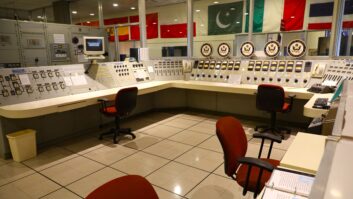Cumulus/Dickey Broadcasting Help the Atlanta Hawks Hit the Airwaves
May 1, 2011 1:00 AM, By Michael Gay

Outside the pre/post game broadcasting studio
See how Cumulus Media and Dickey Broadcasting overcame challenges like that the Hawks play-by-play equipment would need an update, but a permanent play-by-play position could not be created due to the arena’s multi-use functionality.
Philips Arena was built in 1999, with the ability to seat more than 18,000 for sporting events and 21,000 for concerts. The project required key components that would need to overcome the challenges of building inside one of the busiest multi-use facilities in the country. The Hawks play-by-play equipment would need an update, but a permanent play-by-play position could not be created due to the arena’s multi-use functionality. Upgrades planned for the Thrashers play-by-play were not imperative, although with their position being a secure and permanent one in the arena, a rewire and clean up made its utilization as a central hub of communications back to the broadcast studios an obvious choice.

John Kincade, the voice of the Atlanta Hawks broadcasting live in the studio
A new addition
Construction of a pre- and post-game studio inside the arena was vital. Several things to take into consideration during this part of the project were the multi-use aspects of the arena, though game day coverage would be integral with programming. Like the “Buck and Kincade show” in the afternoons, our other music format stations would benefit with live broadcasts from this studio during concerts and other relevant events at the arena. Dickey Broadcasting partnered with WellStar Health Systems to give WellStar the naming rights to the showcase studio. WellStar’s brand is now constantly associated with Dickey Broadcasting’s team-based broadcasts via digital signage that clearly displays their name and logo from inside the broadcast booth before, during and after every game.

Four Philips LCD monitors sit behind the talent positions
Clearly, an abundance of audio connections between the multiple locations inside the arena would be required to facilitate the communications between the play-by-play positions, the pregame studio, and the broadcast studios off-site. Philips Arena has existing multi-pair audio lines from numerous locations that all terminate in the broadcast truck bay; this did not give us our required flexibility, enough paths, and would have created extremely long analog runs. These factors in conjunction with the risk of the occasional accidental cable pull, made it clear that running fiber would be the best solution to facilitate our needs for broadcast and distribution.
The most flexible solution was an IP-audio network over fiber-optic cable. Three pairs of single-mode fiber were installed between the Thrashers play-by-play booth, the Hawks play-by-play position, and the new pre/postgame studio. A pair of HP ProCurve 2510G switches equipped with fiber GBICs were added to facilitate the IP connectivity.

The producer’s desk features a Mackie mixer on Omnirax furniture
Upon completion of a robust IP network at the arena, the next decision was how to transport the audio. A significant amount of Wheatstone IP blades for audio-over-IP networking had just been utilized during a recently completed studio build at Dickey Broadcasting’s WCNN AM 680 The Fan. The engineering team was well versed in the setup, operation and maintenance of these units, thus we continued with this equipment. Three Wheatstone IP88a blades were used to create connections between the various broadcast locations within Philips Arena. A WorldCast Oslo system was used to terminate both ends of the T1 point-to-point that was installed between the broadcast facility at WCNN and the rack in the Thrashers play-by-play booth, thus finalizing the configuration of three pairs of bidirectional channels for connectivity.
Permanent portability

The equipment rack sits behind the producer’s desk
Now that the connectivity and wiring issues were addressed, the next challenge was properly equipping the Hawks play-by-play position. The advantage of Philips Arena being a multi-use facility should not be a disadvantage to the operation; therefore, a portable solution for this position was required despite the fact that it would be in the same location each time. The high expectation of technical standards would remain, starting with the fiber that was run to the location in the arena. The Hawks portable rig consisted of a Wheatstone IP88a blade, AirTools 2X Dual Voice Processor, and a Presonus HP60 headphone amplifier all packaged neatly in a SKB Studio Flyer rolling rack. The talent was fitted with Sennheiser HMD26 headsets and a Lectrosonics HM transmitter fitted to an Electro-Voice RE50B, used for walk-off interviews of players and coaches, all being mixed using a Mackie 140VLZ3PRO at the Hawks play-by-play location.
Due to the space constraints and the non-permanence of this position, wireless microphone receivers were placed in the Thrashers’ permanent play-by-play booth. The elevation of the booth in the arena made this an ideal location for the antennas. Sennheiser ME66 shotgun microphones were also placed in the Thrashers’ booth for F/X miking. The audio from the wireless receiver and the shotgun mics is then delivered to the mixer using the fiber network. The final mix goes back over the network to be processed by a carefully tuned Arianne Sequel before it is sent to the Oslo system for transport to the broadcast studio. Early on, there was concern about the performance of the Wheatstone blade with the repetitive connection/disconnection activity due to the uniqueness of the portable position of the Hawks within the arena. Pleasingly, this has not been an issue, with the blades syncing up and transporting audio in less than two seconds.

The modified cough box and mic setup features adjustable volume and custom labeling.
The approach to the pre- and post-game studio construction at Philips Arena was to draw on what had been learned from the construction of similar projects in the past, including the build at Turner Field for the Atlanta Braves. Keeping similar elements in both projects would be the key to efficiency with engineering and design. Early in the design phase, management at Phillips Arena offered the use of the extra hockey glass that was hanging around the facility, showing off a stack of 4′ � 8′ sheets of tempered glass stamped with the NHL certification and the Crystaplex manufacturer’s logo. The glass had been previously used in the arena, with some of hockey’s greats being slammed against it. A few minor dings and scratches would simply add character, but for the most part, the glass was crystal clear. With the use of this glass, a studio could be created enabling a view of the talent from any angle, enhanced by a 20′ span of glass on the front fa�ade. The general contractor, O’Brien & Associates in Buford, GA, operating as a division of WeatherTite Windows was excited to be a part of the project. The structural steel beams and framework of the roof were designed to mimic the curved roofline of Philips.
— continued on page 2
Cumulus/Dickey Broadcasting Help the Atlanta Hawks Hit the Airwaves
May 1, 2011 1:00 AM, By Michael Gay

Portable rack for Atlanta Hawk’s games
Inside to outside
Once the booth was built, the concentration turned to the interior from a technical and an aesthetic standpoint. As luck would have it, a local company called Fanmats was discovered that made carpet tiles with the logos for the Hawks and the Thrashers, as well as other sports franchises, using a special chromojet process that embeds the color into the fiber. The studio furniture, including a SportsCenter-style desk, as well as the producer position and rack, was designed and fabricated by Omnirax. Four 42″ Philips BDL4251V LCD monitors were set up for an array behind the talent inside the booth. In addition to this, a 1′ � 8′ array of these monitors was set up, crossing the entire 25′ span above the escalators heading upstairs to the area where the studio resides. These provide an effective way to draw attention to the broadcast as well as a way to promote sponsors.
Engineering TeamGary Kline, VP engineering and IT, Cumulus Media
Michael Gay, project manager, Cumulus Media
Marc Lehmuth, market DOE, Cumulus and Dickey Broadcasting/Atlanta
Timothy Stephens, chief engineer, Cumulus and Dickey Broadcasting/Atlanta
There is no doubt that the studio is fully functional and ready to go when the talent sits down behind the ever ubiquitous Electro-Voice RE-27 microphones on 309A mounts combined with Sony MDR-7505 headphones. The gathering crowd outside is treated to a live broadcast via a pair of JBL Control 28 speakers. All the mixing is performed on a Mackie 1642-VLZ3 at the producer position. Multiple audio buses allow a customized mix for the crowd and for bidirectional producer talkback to the talent in the facility as well as the broadcast studio back at WCNN.

The broadcasting setup for the Atlanta Thrashers hockey team
Pro Co Sound Short Stops were modified to create a cough box complete with headphone volume control and custom labeling. The inputs to the Wheatstone blade are protected by an Aphex Compellor 320D while the final feed is delivered to the broadcast facility at The Fan via the Oslo system.
Equipment listAirTools Voice Processor 2x
Aphex Compellor 320D
APT WorldNet Oslo
Canare Starquad
Crown CTS4200 Quad Amplifier
Denon DNC640
Electro-Voice RE27
Gepco 61801EZGF
HP Z400 Quad Core PC
JBL Control 1 PRO, Control 28
Lectrosonics HM plug, IFBT4, R1a, SMQV, VRMWB
Mackie 1642-VLZ3, 1402-VLZPRO
Matrox M9140
Neutrik Gold XLR and �” connectors
Omnirax cabinetry
Philips BDL4251 Digital Signage Displays
Philips PFL3505D
Premier Tilt Mount P2642T
Presonus HP60
Pro Co Sound Short Stop (modified by Cumulus)
Sennheiser HMD 25, ME 66
SKB Studio Flyer 1SKB19-RSF4U
Sony MDR7505
Tascam TU690
Telos Zephyr XStream
TransLanTech Sound Ariane Sequel
Wheatstone IP88a
It was an exciting yet challenging opportunity to build an audio-over-IP network inside one of the busiest concert and sporting venues in the country. The benefit of having full-time connectivity to the broadcast facility is great with the guys able to come in and start working without calling the station to coordinate dialing in on an ISDN line. The design and build teams of Dickey Broadcasting and Cumulus Media had a lot of fun on this project and the engineering team takes pride in being a part of a project that can be seen and heard by a plethora of people who pass through the arena each year.
Gay is a project manager for Cumulus.
Thanks to Liz Haddon for assistance in preparing this article.
— images continued on page 3
Cumulus/Dickey Broadcasting Help the Atlanta Hawks Hit the Airwaves
May 1, 2011 1:00 AM, By Michael Gay









— images continued on page 4
Cumulus/Dickey Broadcasting Help the Atlanta Hawks Hit the Airwaves
May 1, 2011 1:00 AM, By Michael Gay






Cumulus/Dickey Broadcast Baseball
The plan included a complete makeover of the play-by-play broadcast booth and the construction of a new pre/post-game stage in the Grand Entry Plaza. …
May 2011
Voice over IP for on-air phones, Cumulus/Dickey Broadcasting help the Atlanta Hawks hit the airwaves, tips on using the ULS, and Field Reports on the Electro-Voice RE320 and Yamaha Stagepas 300….
Contributor Pro-File: Michael Gay
This month: Michael Gay, IT/project manager, Cumulus Media, Atlanta…







